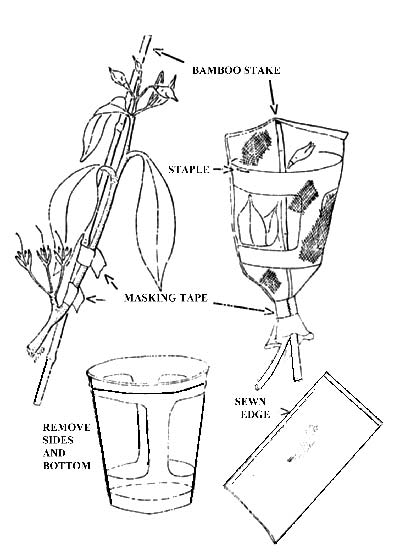QBARS - v35n3 Small Breeding Cages for Field or Garden
Small Breeding Cages For Field or Garden
William H. Gensel, Durham, North Carolina
This research was supported by a Grant-in-Aid from the Highlands Biological Station, Highlands, N.C. and the N.C. State Horticultural Science Department

|
|---|
Various methods for the isolation of emasculated flowers from pollinators have been devised. Often they have proven to be awkward, costly or constructed of materials unsuited for field use. Examples of such devices include cages placed over whole plants and stigma isolation techniques using bits of tape, aluminum foil or pieces of drinking straws. The following method and device was used successfully in the spring and summer of 1980 in the mountains of North Carolina during my research into the reproductive biology of the southeastern U.S. lepidote rhododendrons. The cage is inexpensive, weather resistant, resilient, allows a nearly natural circulation of air throughout the flower truss, and excludes all insects capable of pollination.
A sleeve was fashioned by folding over and sewing two edges of a rectangle of mosquito netting (Fig. 1). The dimensions were determined by trial and error so that the netting would fit snugly over a plastic cup of suitable size (16 oz for Rhododendron carolinianum Rehder), and to extend down the branch to be fastened with string or masking tape. The bottom and 80% of the sides of the cup were removed to form two approximately equal sized windows. The uncut lip of the cup was first inserted into the sleeve and then stapled to the net.
In the field, a suitable truss was selected, open and tight buds removed, leaving buds of suitable size to be emasculated just prior to their opening. A lightweight twig or bamboo stake was taped to the stem to support the cage. The cage was easy to remove and replace prior to and following hand pollination without damaging any flowers in the truss or the developing vegetative growth.
A fellow graduate student at N.C. State University used nylon stocking material to cage Saxifriga which were supported by bamboo stakes pushed into the ground. Nylon stockings were initially tried with rhododendron but the nylon waterlogged and collapsed against the flowers. This material, however, might be satisfactory for garden use.

